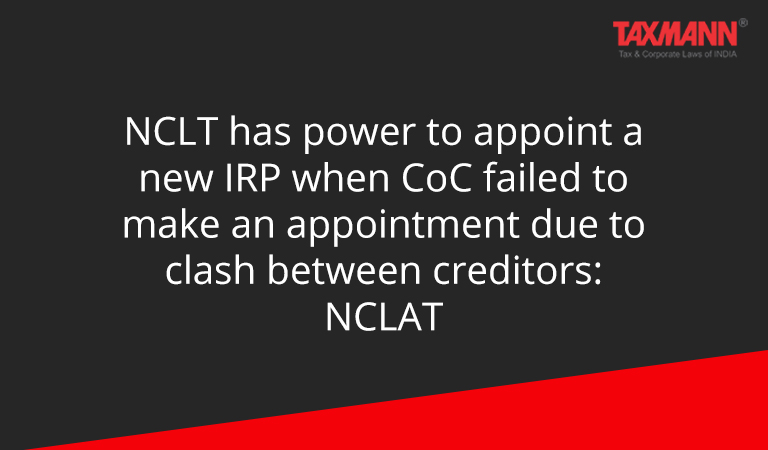NCLT has power to appoint a new IRP when CoC failed to make an appointment due to clash between creditors: NCLAT
- Blog|News|Insolvency and Bankruptcy Code|
- 2 Min Read
- By Taxmann
- |
- Last Updated on 9 November, 2021
Case Details: Anil Kumar v. Allahabad Bank - [2021] 131 taxmann.com 334 (NCLAT- New Delhi)
Judiciary and Counsel Details
-
- Anant Bijay Singh, Judicial Member and Ms. Shreesha Merla, Technical Member
- Rajendra Beniwal, Chirag Gupta, Kumar Sumit and Anil Kumar (RP), Advs. for the Appellant.
- Ms. Honey Satpal, Ms. Niti Arora Sachar and Samriddh Bindal, Kiran Shah, CA Siddharth Tandon and Saurabh Kalia for the Respondent.
Facts of the Case
Pursuant to the admission of an application filed under section 7 of the Insolvency and Bankruptcy Code, the appellant was appointed as Interim Resolution Professional (IRP) and made a public announcement, and thereafter Committee of Creditors (CoC) was constituted.
In the Committee of Creditors (CoC) meeting, the IRP provided a list of Financial Creditors along with the voting shares for each creditor. The respondent bank, on the other hand, raised its concern in relation to the eligibility of the Corporates mentioned in the list of Creditors. It was of the view that the correct classification of creditors was critical to the constitution of CoC.
Thereafter, the respondent Bank and other financial creditors requested the appellant and IRP to provide clarity about the classification of financial creditors the whole problem had aroused with regard to the appointment of IRP/RP as no majority could be reached into the appointment of IRP/RP and, therefore, an application was filed before NCLT.
The NCLT by impugned order while exercising its inherent powers under rule 11 of the NCLT Rules, 2016 allowed the application and appointed ‘K’ as the new IRP for the Corporate Insolvency Resolution Proceedings (CIRP).
On appeal, the appellant submitted that none of the powers under sections 22 and 27 were exercised rather the Adjudicating Authority had passed the impugned order invoking power under ‘Rule 11’ of the NCLT, so the impugned order passed by Adjudicating Authority could not be sustained by law and was fit to be set aside.
NCLAT Held
The NCLAT took the reference of section 22 and section 27 which contemplate the appointment of Resolution Professional and replacement of Resolution Professional by Committee of Creditors respectively.
In the facts of the instant case, neither the ingredients of section 22 nor section 27 were made out. Hence, the Adjudicating Authority had rightly invoked inherent jurisdiction and passed the impugned order.
In addition to foregoing, the appellant could not provide leadership to CIRP proceedings and there was a clash between secured and unsecured creditors and the timeline for CIRP proceedings was running out. As a result, the Adjudicating Authority had rightly exercised inherent power and appointed a new IRP.
Disclaimer: The content/information published on the website is only for general information of the user and shall not be construed as legal advice. While the Taxmann has exercised reasonable efforts to ensure the veracity of information/content published, Taxmann shall be under no liability in any manner whatsoever for incorrect information, if any.

Taxmann Publications has a dedicated in-house Research & Editorial Team. This team consists of a team of Chartered Accountants, Company Secretaries, and Lawyers. This team works under the guidance and supervision of editor-in-chief Mr Rakesh Bhargava.
The Research and Editorial Team is responsible for developing reliable and accurate content for the readers. The team follows the six-sigma approach to achieve the benchmark of zero error in its publications and research platforms. The team ensures that the following publication guidelines are thoroughly followed while developing the content:
- The statutory material is obtained only from the authorized and reliable sources
- All the latest developments in the judicial and legislative fields are covered
- Prepare the analytical write-ups on current, controversial, and important issues to help the readers to understand the concept and its implications
- Every content published by Taxmann is complete, accurate and lucid
- All evidence-based statements are supported with proper reference to Section, Circular No., Notification No. or citations
- The golden rules of grammar, style and consistency are thoroughly followed
- Font and size that’s easy to read and remain consistent across all imprint and digital publications are applied








 CA | CS | CMA
CA | CS | CMA


